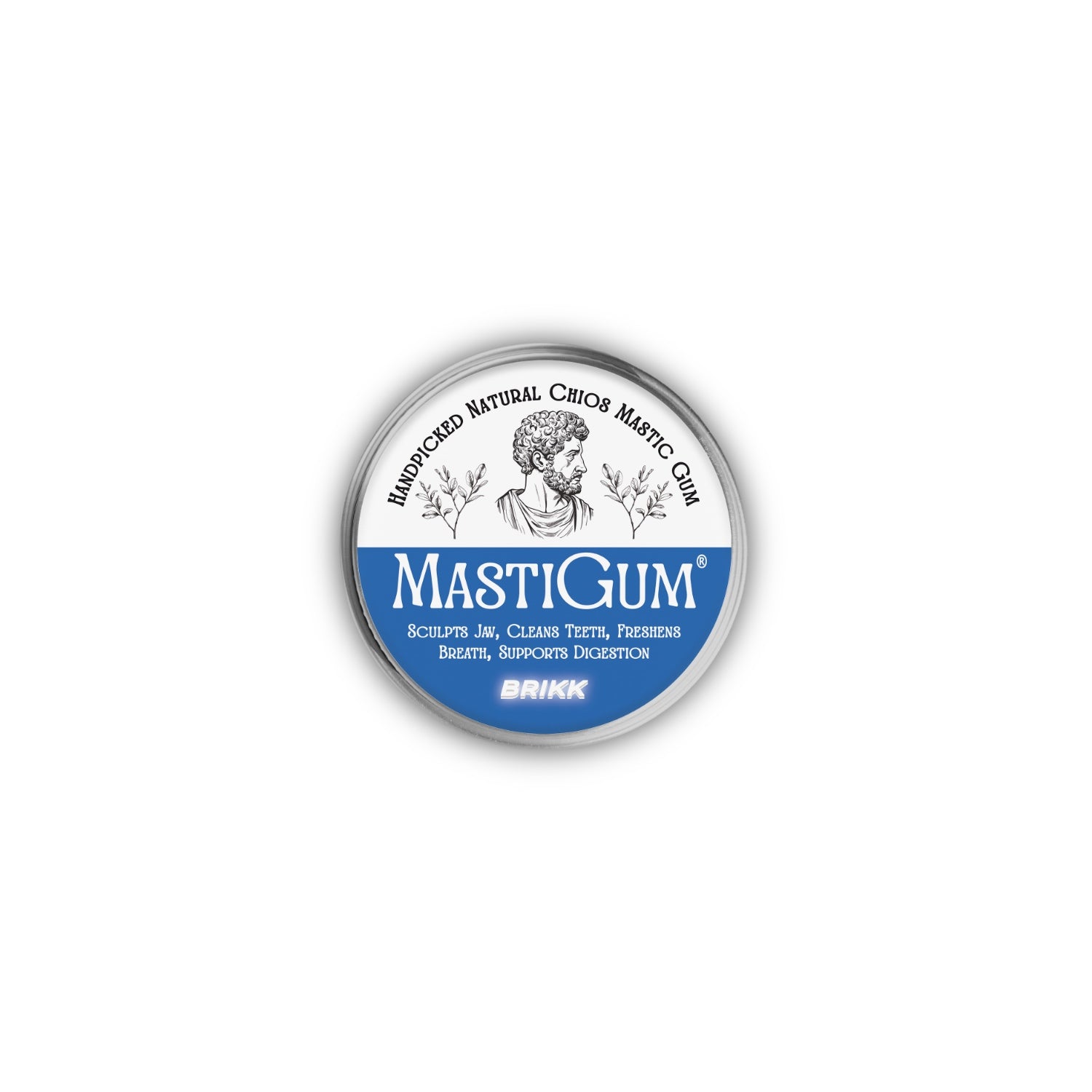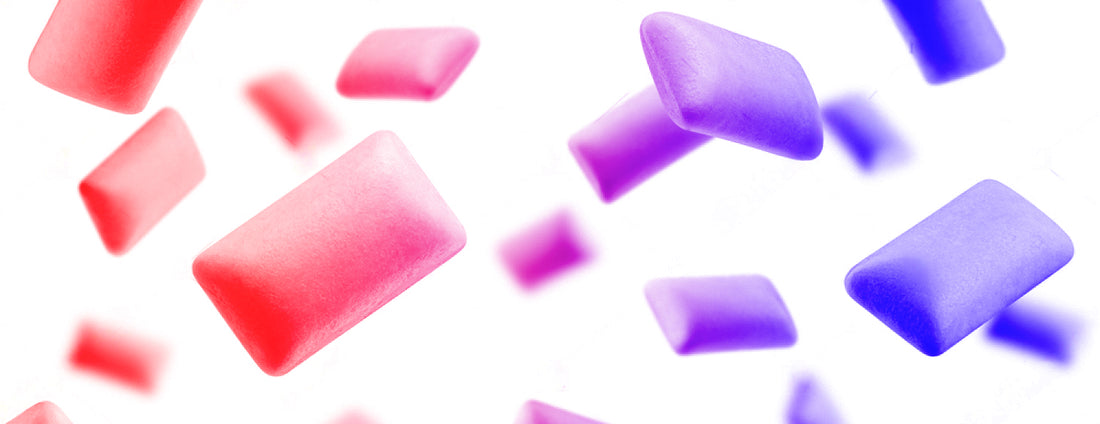Many of us enjoy chewing gum to refresh our breath or improve the taste in our mouths. However, could there be some harmful ingredients behind the attractive packaging and promises of fresh breath and white teeth?
In this article, we will try to uncover the truth. We will reveal whether gums are truly harmless, even beneficial, or if they could be a hidden threat to our health.
All sources used are cited,so that you can verify the facts and claims for yourself.

Looking at the fine print on the back of a gum wrapper, we find ingredients such as:
- Gum base
- Natural or artificial flavor and taste
- Artificial sweeteners - Aspartame or Acesulfame K
- Hydrogenated oil
- Dyes
- Whitening agent - Titanium dioxide
- Alcohol sugars - Sorbitol, xylitol, mannitol, maltitol
- Preservatives BHA and BHT
- Soy lecithin
- Glycerin or Glycerol
- Fluorides
Ingredients in Gum: What are you really chewing?
Gum Base: What makes gum chewy - plastics, softeners, fillers, and resins
This term denotes a mixture of substances that give gum its characteristic properties.
This mixture contains arabic gum, elastomers, softeners, fillers, and resins. Other components include PVA - a type of plastic often called "crafting silicone" and hard paraffin, a byproduct of oil refining. These substances are released into our bodies as we chew. 1,2
- Another concern is microplastics - tiny plastic particles that penetrate the blood, brain, and female placenta! Gums are a known source of microplastics. 3,4
- These substances are often associated with hormonal imbalances, damage to the digestive tract, disorders of the nervous system and brain, chronic diseases, and cancer development. 4,5,6
Aspartame and Acesulfame K: Carcinogenic sweeteners that damage the gut microbiome and cause psychological issues
Artificial sweeteners, frequently used in gums or "healthy" fitness protein drinks as sugar substitutes, can be considered among the most toxic substances for the human body.
- Aspartame stimulates appetite. Searle & Company, which developed this artificial sweetener, struck a deal with C*ca-Cola to use the sweetener in diet beverages in 1983. The FDA approved both sweeteners for human consumption under questionable circumstances and without sufficient research on their impact on human health. 7,8
- The WHO (World Health Organization) plans to reclassify aspartame as a Class 2B carcinogen in July 2023, officially labeling it a "possible human carcinogen.” 9
- They're associated with every known brain disease, including Alzheimer's and Amyotrophic Lateral Sclerosis (ALS). They contribute to other diseases like diabetes, multiple sclerosis, asthma, obesity, and more. They disrupt the function of the digestive system, destroy the gut microbiome, and are linked to the onset of psychological disorders and depression. 10,11,12
Hydrogenated Oils: A source of dangerous trans fats
Hydrogenation is a chemical process that involves adding hydrogen atoms to carbon molecular bonds with the help of a catalyst - often nickel or platinum. This process transforms liquid oils into solid fats at room temperature - vegetable oil into margarine.
Trans fats, known for their toxicity, are produced during the hydrogenation process. 13
-
Trans fats are associated with various health problems, including an increased risk of heart disease, diabetes, and obesity. 14
Dyes: Are children's gums causing attention disorders and hyperactivity?
Yellow 5 (E102), Red 40 (E129), or Blue 1 (E133). Gums for children are often colored with various chemicals that have a range of adverse health effects.
-
These dyes are frequently associated with various health issues, including hormonal imbalances, disrupted nutrient absorption function, and neurotoxicity - memory, concentration, and hyperactivity issues. 15,16,17
Titanium Dioxide: A bleach that damages DNA and causes cancer
It's a nanoparticle commonly used in sunscreens, toothpaste, make-up, and other cosmetic products.
-
Classified as a 2B carcinogen by the IARC - International Agency for Research on Cancer.18
- Damages the immune system and the intestinal barrier. Some studies suggest that titanium dioxide may cause DNA damage. It accumulates in organs.19,20
Sorbitol, Xylitol, Mannitol, Maltitol: Sugar alcohols causing bloating and gas
They are types of sugar alcohols used as sugar substitutes. Although these substances are lower in calories and may be suitable for diabetics, they are also known for their adverse health effects.
-
They can cause digestive issues such as bloating, gas, and diarrhea. They cause allergic reactions and increase the risk of dental caries.21,22
BHT or BHA: Preservatives disrupting hormonal function
They are preservatives used in food products and chewing gums.
- Animal studies suggest they cause cancer. BHA acts as an endocrine disruptor - it disrupts hormonal function.
-
Prolonged use causes issues with the liver, thyroid, and kidneys. Some studies indicate they cause reproductive system problems and infertility. 23,24
Fluoride: According to Harvard scientists, it accumulates in the body, penetrates the brain, and reduces IQ
Fluoride is a highly reactive non-essential mineral, often added to toothpaste and whitening gums.
Fluorides can penetrate the blood-brain barrier into brain tissue. It has been proven to disrupt the brain’s and other organs’ metabolic processes. 64 out of 72 studies found that fluorides result in a drop in IQ. Over 60 studies found that fluorides hurt memory and learning ability.
New research shows a minimal link between fluorides and a reduced risk of dental caries. 25,26,27,28
- Most commonly in forms: Fluosilicic Acid, Sodium Fluoride (NaF), and Sodium Hexafluorosilicate (Na2SiF6).
- It is not known that fluoride has a fundamental role in human growth and development, and no symptoms of its deficiency have been found in humans. Only 50% of the daily intake of fluorides is excreted by the kidneys. The rest accumulates in the bones, pineal gland, and other tissues throughout life. 29,30,31,32
-
Known effects of fluoride accumulation in tissues: Dental fluorosis, Skeletal fluorosis, Calcification of the pineal gland, Reduced IQ, Memory and learning impairment, Infertility, Neurotoxicity, Cardiotoxicity, Endocrine system disruption, Hepatotoxicity, Nephrotoxicity, Melatonin production disruption - insomnia, ADHD, Alzheimer's disease. 26,27,28,33,34,35
So, what's the deal with gums? The truth is, there's nothing beneficial or natural about gum. They could be characterized as a mixture of neurotoxic and carcinogenic chemicals disrupting the hormonal system.
If you don't mind chewing plastic, that's your call.
But is it worth risking the onset of chronic diseases just for breath refreshment?
Fortunately, we have some good news for you. We recommend MastiGum® - 100% natural premium chewing resin to avoid all toxic chemicals. Mastic has been used as a gum since ancient Egyptian times. It refreshes breath and supports digestion, exercises jaw muscles, has anti-inflammatory and antibacterial properties, cleans teeth, and improves dental and gum health.
Try MastiGum and experience the difference.
Resources used
1 https://en.wikipedia.org/wiki/Chewing_gum
2 https://www.mysciencework.com/patent/show/polyvinylacetate-bubble-gum-base-composition-EP0242325B1
3 https://www.ncbi.nlm.nih.gov/pmc/articles/PMC10151227/
4 https://www.ncbi.nlm.nih.gov/pmc/articles/PMC7068600/
5 https://www.genevaenvironmentnetwork.org/resources/updates/plastics-and-health/
6 https://www.endocrine.org/news-and-advocacy/news-room/2020/plastics-pose-threat-to-human-health
7 https://www.coca-colacompany.com/about-us/faq
10 https://www.healthline.com/health/aspartame-side-effects#side-effects
11 https://pubmed.ncbi.nlm.nih.gov/35324894/
12 https://ehjournal.biomedcentral.com/articles/10.1186/s12940-021-00725-y
13 https://www.fda.gov/food/food-additives-petitions/trans-fat
14 https://www.healthline.com/nutrition/why-trans-fats-are-bad#heart-health
15 https://www.healthline.com/nutrition/food-dyes#TOC_TITLE_HDR_5
16 https://pubmed.ncbi.nlm.nih.gov/23026007/
17 https://www.ncbi.nlm.nih.gov/pmc/articles/PMC2957945/
18 https://www.ccohs.ca/headlines/text186.html
19 https://www.healthline.com/nutrition/titanium-dioxide-in-food#risks
21 https://www.healthline.com/nutrition/sugar-alcohols-good-or-bad#bottom-line
21 https://health.clevelandclinic.org/what-to-know-about-sugar-alcohols/
23 https://davidsuzuki.org/living-green/dirty-dozen-bha-bht/
24 https://pubmed.ncbi.nlm.nih.gov/12396675/
25 https://en.wikipedia.org/wiki/Fluoride
26 https://www.ncbi.nlm.nih.gov/pmc/articles/PMC9866357/
27 https://www.ncbi.nlm.nih.gov/pmc/articles/PMC8700808/
28 https://www.hsph.harvard.edu/news/features/fluoride-childrens-health-grandjean-choi/
29 https://www.efsa.europa.eu/en/efsajournal/pub/3332
30 https://pubmed.ncbi.nlm.nih.gov/3295994/
31 https://www.hsph.harvard.edu/nutritionsource/fluoride/
32 https://www.ncbi.nlm.nih.gov/pmc/articles/PMC6309358/
33 https://www.healthline.com/nutrition/fluoride-good-or-bad#bottom-line
34 https://pubmed.ncbi.nlm.nih.gov/34597567/
35 https://hubermanlab.com/how-to-optimize-your-water-quality-and-intake-for-health/


